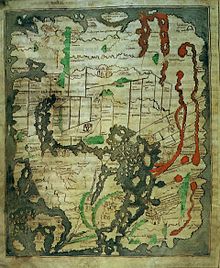Name of Hungary
This article needs additional citations for verification. (June 2016) |
Hungary, the name in English for
Name of the Hungarians and Hungary
Endonym of the ethnic group and country

Primary sources use several names for the Magyars/Hungarians.

The Hungarian endonym is Magyar, which is derived from
European exonyms for Hungarians and Hungary
In early medieval sources, in addition to the Hungarians, the exonym Ungri or Ugri referred to the
In
of 881.The ethnonym Ungri is the Latinized form of
The Latin variant Ungarii used for them by
The origin of the English ethnonym and country name
The English word "Hungary" is derived from Medieval Latin Hungaria.[16]
Hungarian sources
According to one view, following Anonymus's description, the Hungarian federation in the 9th century was called Hetumoger ("Seven Magyars"): VII principales persone qui Hetumoger dicuntur ("seven princely persons who are called Seven Magyars"[17]), though the Chronicler refers to "seven leading persons"[18] instead of a polity.[19]
Other sources
In Byzantine sources in Medieval Greek, the nation was denominated the "Western Tourkia".[20][21] Hasdai ibn Shaprut denominated the polity "the land of the Hungrin" ("the land of the Hungarians") in a letter to Joseph of the Khazars of c. 960.[22]
Natio Hungarica
The
Pannonia
Pannonia is a
Later, the territory of the medieval Kingdom of Hungary included that of former Pannonia, and Medieval Latin transferred the denomination of Pannonia to the territory of the Western parts of the Kingdom of Hungary. Further, the King of Hungary was given the title of Rex Pannoniae ("King of Pannonia") and Rex Pannonicorum ("King of the Pannonians").
The name "Pannonian" comes from Pannonia, a province of the Roman Empire. Only the western part of the territory (the so-called Transdanubia) of modern Hungary formed part of the ancient Roman Province of Pannonia; this comprises less than 29% of modern Hungary, therefore Hungarian geographers avoid the terms "Pannonian Basin" and "Pannonian Plain".
Modern era
The Latin Regnum Hungariae or Regnum Ungarie (Regnum meaning "kingdom"); Regnum Marianum (meaning "Kingdom of
The name of the Kingdom in other languages of its inhabitants was:
The Italian Regno d'Ungheria ("Kingdom of Hungary") alone denominated the Free State of Fiume for its existence from 1920–24, the City of Fiume (contemporarily Rijeka, Croatia, but still denominated Fiume in Hungarian) of which the Free State was predominantly comprised having been within the territory of the Kingdom from 1776–1920.
In and during the
Lands of the Crown of Saint Stephen
"Lands of the
Regnum Marianum
Regnum Marianum ("Kingdom of Mary") is a traditional
Regnum Marianum was often used to emphasize the predominant Roman Catholic Faith of Hungary. Some Hungarian religious communities also bear the name to express their intent to honor and imitate the life of St. Mary, including the Regnum Marianum Community, whose foundation in 1902 evidences the use of the phrase to denominate Hungary since at least that date.
References
- ^ a b Kristó 1996a, p. 229.
- ]
- ISBN 978-90-04-21437-8.
- ISBN 9780230583474.
- ^ György Balázs, Károly Szelényi, The Magyars: the birth of a European nation, Corvina, 1989, p. 8
- ^ Alan W. Ertl, Toward an Understanding of Europe: A Political Economic Précis of Continental Integration, Universal-Publishers, 2008, p. 358
- ^ Z. J. Kosztolnyik, Hungary under the early Árpáds: 890s to 1063, Eastern European Monographs, 2002, p. 3
- ISBN 0-88033-503-3, Library of congress control number 2002112276
- ^ Sergei Starostin, Uralic etymology
- ^ The Linguist: Journal of the Institute of Linguists, Volumes 36–37, The Institute, 1997, p. 116
- OED, s. v. "Ugrian": "Ugri, the name given by early Russian writers to an Asiatic race dwelling east of the Ural Mountains".
- ^ Iván Boldizsár, The New Hungarian Quarterly, Issues 121–123, Lapkiadó Publishing House, 1991, p. 90
- ]
- ^ ]
- ISBN 978-0-253-20867-5. Retrieved 2011-07-06.
- ^ Oxford Dictionaries
Online Etymology Dictionary - ^ Gyula Decsy, A. J. Bodrogligeti, Ural-Altaische Jahrbücher, Volume 63, Otto Harrassowitz, 1991, p. 99
- ^ Anonymus, Notary of King Béla: The Deeds of the Hungarians 2010, (chapter 1), p. 11.
- ^ Kristó 1996a, pp. 116–117.
- ^ Peter B. Golden, Nomads and their neighbours in the Russian steppe: Turks, Khazars and Qipchaqs, Ashgate/Variorum, 2003. "Tenth-century Byzantine sources, speaking in cultural more than ethnic terms, acknowledged a wide zone of diffusion by referring to the Khazar lands as 'Eastern Tourkia' and Hungary as 'Western Tourkia.'" Carter Vaughn Findley, The Turks in the World History Archived 2016-02-05 at the Wayback Machine, Oxford University Press, 2005, p. 51, citing Peter B. Golden, 'Imperial Ideology and the Sources of Political Unity Amongst the Pre-Činggisid Nomads of Western Eurasia,' Archivum Eurasiae Medii Aevi 2 (1982), 37–76.
- ^ Carter V. Findley, The Turks in world history, Oxford University Press, 2005, p. 51
- ISBN 978-0814325612
- ^ "Transylvania - the Roots of Ethnic Conflict".
- ISBN 978-0-684-31359-7
- ISBN 978-4-938637-43-9
- ISBN 978-0-7546-6525-0
- ^ Chisholm, Hugh, ed. (1911). . Encyclopædia Britannica. Vol. 13 (11th ed.). Cambridge University Press. pp. 894–931.
- ^ Introduction to Constitution of Union between Hungary and Croatia, Slavonia, and Dalmatia
- ISBN 0-86516-422-3.
Secondary sources
- Kristó, Gyula (1996a). Hungarian History in the Ninth Century. Szegedi Középkorász Muhely. ISBN 963-482-113-8.
- Marcantonio, Angela (2002). The Uralic Language Family: Facts, Myths and Statistics. Oxford ; Malden, MA: Blackwell.
See also
- Lands of the Crown of Saint Stephen
- Pannonia
- Transleithania
- Yugra
